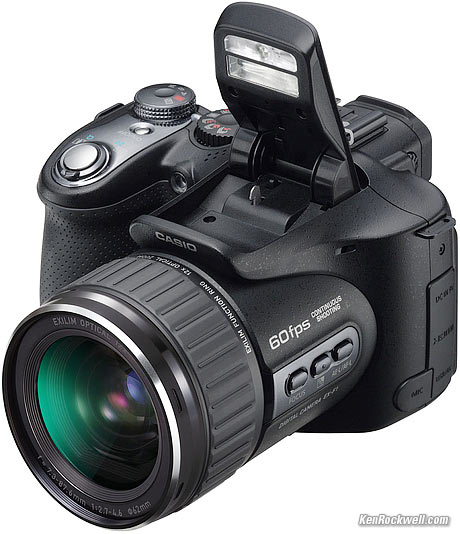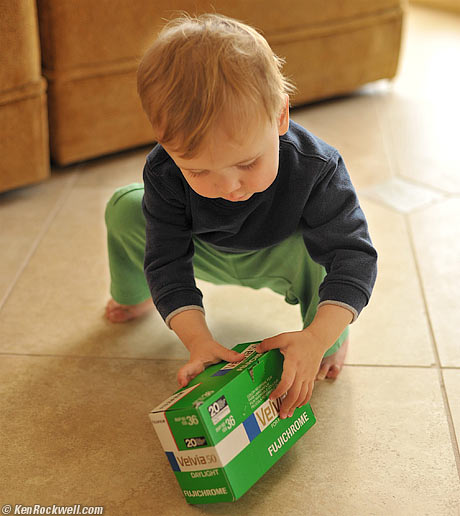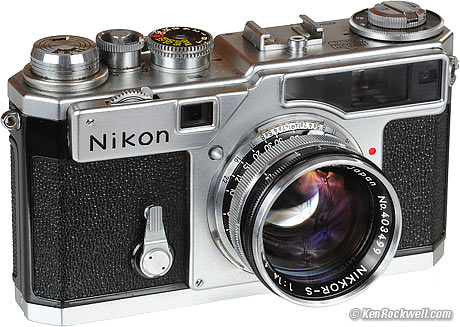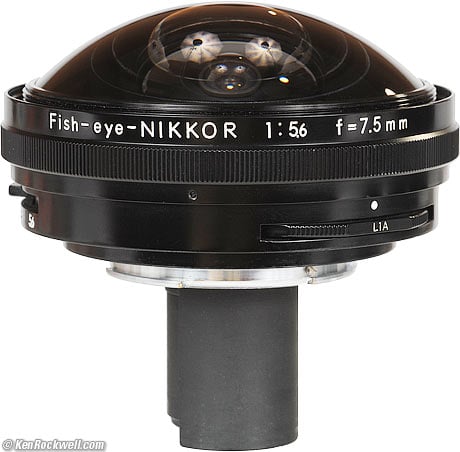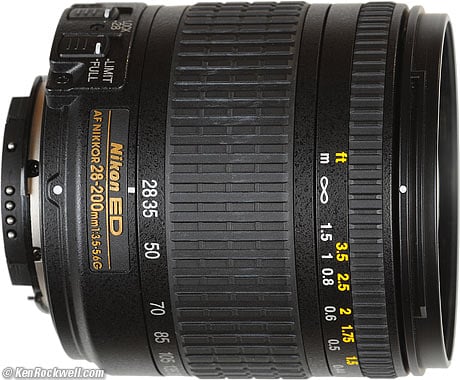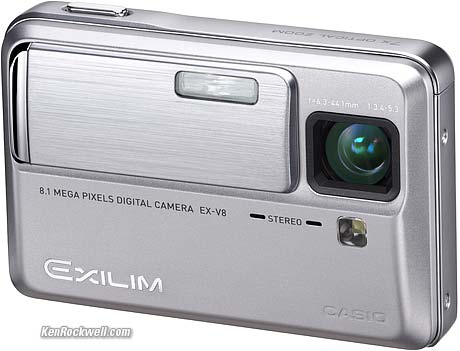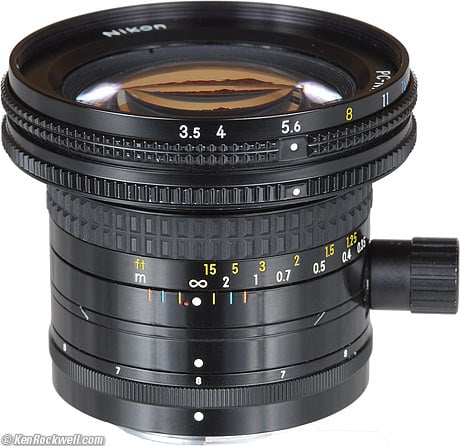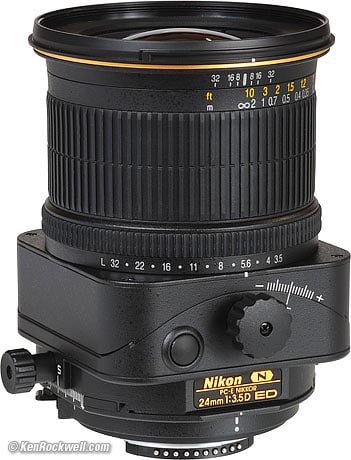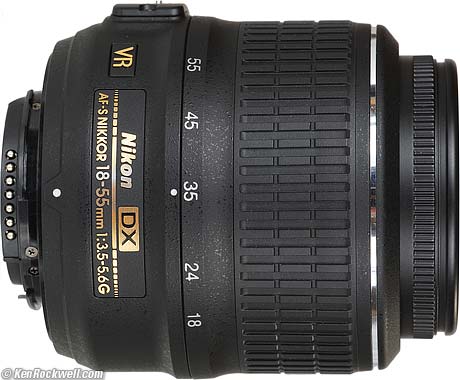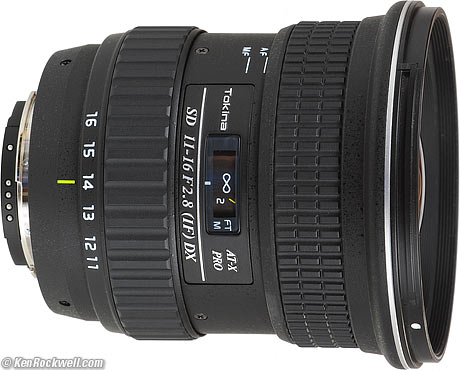Home Search Gallery How-To Books Links Workshops About Contact
April 2008's
Updates RSS I get my
goodies at Ritz, Amazon, Adorama.
It helps me
Baby Ryan Rockwell. Cute photos with tech data. NEW: Nikon D3 D60 D300 60mm 24mm PC 16-85mm VR Canon XSi 1Ds Mk III 14mm II 18-55mm IS 55-250mm IS Recommended Cameras Nikon Reviews Canon Reviews
29 April 2008, Tuesday NEW: I added observations and suggestions while using the D3's second card slot as a backup. NEW: Nikon 8mm f/2.8 Fisheye Review. It's about 39 pages if printed out (which would be a silly thing to do). Is this enough detail for you folks? I remember when I had a real job with managers. No way would any commercial venture let someone spend as much time as I did on this review. If anyone has a 6mm f/5.6 or 6mm f/2.8, I'd love to get to review it, too. Addition: Added some lame examples to my Fisheye Hemi review. News: Canon announces today that it's made its 40 millionth EF lens. Nikon announced last year that it hit 40 million Nikkor lenses, but one needs to realize that Canon EF lenses aren't all Canon lenses ever made, but merely Canon's current series of AF lenses made since 1987. Canon claims 64 current models, the broadest line of lenses in the industry. I sure hope Nikon is working on some new fast, fixed FX lenses to try to catch up. Nikon's FX normal and wide fixed lenses are mostly 10 to 30 year old designs, and the good ones, like the 28mm f/1.4, are already discontinued, with no current replacements.
28 April 2008, Monday New: Casio EX-F1 overview. This is a new kind of camera for sports with triple the pixel rate and six times the frame rate of the Nikon D3 or Canon 1D Mk III. The Casio EX-F1 shoots at 60 frames per second with full 6 MP resolution. The EX-F1 can also shoot images continuously and then save the shots made before you press the shutter, letting you catch the uncatchable! The EX-F1 may be a landmark of a camera for sports and motion. It also shoots HDTV and movies at frame rates up to 1,200 frames per second. 25 April 2008, Friday Surfer's Nightmare: Dr. David Martin, D.V.M., got munched by a great white shark while training for a triathlon off beautiful Solana Beach. If you're planning on visiting San Diego's warm, wonderful waters this weekend, you'll find them closed from Torrey Pines through Carlsbad. R.I.P., Dr. Martin. News: Nikon D3 firmware v1.11 updates. These are to fix the screw-ups in v.1.10. Starting from v 1.10, the A-side firmware took about 10 seconds to update in-camera, and the B-side took two minutes. My D3 works fine, at least just making a snap at my desk. New: Nikon AF-G to Canon EF adapter. Want to use the superior Nikkor 14-24mm as an utterly manual lens on your Canon 5D or 1Ds Mk III? Have at it!
23 April 2008, Wednesday Good gosh: Baby Ryan just felt like wearing the same colors as Fuji Velvia 50's packaging today! (Crappy backlight because kids never do what you want them to, Nikon D3, NEUTRAL and +1 saturation picture control, normal ADR, white-card WB, 50mm f/1.4 AF-D, f/2.8 at 1/60, Auto ISO chose ISO 200.) Nikon SP and 5cm f/1.4 Nikkor-S (1957). enlarge. Observation: Since new digital SLRs (like the long rumored Canon 5D Mark II) probably won't be announced until August, I had a quick look at this 50-year-old Nikon rangefinder . I was astounded that its shutter is the most accurate mechanical shutter I've ever tested: every speed, especially 1/500 and 1/1,000, is closer than one-sixth of a stop to perfect! The RMS error across all speeds was only 0.09 stops, and this is a camera which has sat in a garage unused for about 30 years. The Nikon SP was Nikon's best rangefinder camera, sold from 1957 through about 1963. Of course the Nikon F SLR of 1959 was far better for most things, and put rangefinder cameras off the map. What set it apart is that its finder covers six lenses (28mm, 35mm, 50mm, 85mm, 105mm and 135mm) with no need for the idiotic finders the non-P cameras need for some of these lenses. Earlier cameras lacked these features (and had painful film wind knobs instead of levers and goofy multiple dials for shutter speeds), and later cameras like the S3 were lower-cost models which skipped some features, like the flexible finder system. It also turns out that the authoritative reference book on these oldies, "The Nikon Rangefinder System," by Robert Rotoloni has just been updated for the first time in over twenty years. It just came out in March. (You also can order it directly from the distributor. Tell them I sent you if you get one.) I ordered one for myself to help me sort these out.
21 April 2008, Monday New: Nikon 7.5mm Fisheye review. An ancient lens that's been obsolete since 1970. Hack Request: While all you folks are decompiling Nikon's latest firmware for the D3, how about doing something useful while you're in there? We all need a new menu option to let us set the AF-ON button to select among the various Picture Controls, and we also need a new menu item to allow us to select if Auto-ISO disables in manual exposure mode. THANKS!
19 April 2008, Saturday A reader writes that looking at Nikon's botched v1.10 firmware for the D3, that there are numerous calls for the D3X embedded in it. He tells me the D3X will be 24.4mp as indicated in the the code, a setting was found for 6,048 x 4,032 and other resolutions. Have a hack and let me know what you see. No, silly people, you can't get a D3 to do that resolution. This simply is Nikon putting this in the firmware for whenever the D3X arrives — or for beta samples out testing. I don't expect any D3X announcements until at least the third week of August, 2008.
18 April 2008, Friday New: Nikon 28-200mm AF-G (2003-2006) Review. The page has been there a while; I re-wrote and re-illustrated the entire review. This fantastic plastic zoom is my favorite do-everything lens on the D3. New: Casio EX-V8 review. Casio comes out with cameras so fast that this one has already been discontinued after being in the catalog for only six months. Viewfinders: I'm astounded at how pathetic the finders remain in DX cameras. Nikon's newest, best and most expensive DX camera ever, the $1,800 D300, has a finder the same size as Nikon's cheapest 35mm SLRs ever made, the N55 and N75. Every other Nikon film SLR, even the cheap N70, loathed N60 and the hated-by-collectors-since-1979 EM, have big, beautiful finders that make every DX camera look dim and worthless by comparison. This was driven home again when I peered through an F80 (N80) just sent to The Retirement Ranch by a generous Mr. Collins in Toronto. No one wants these film cameras anymore, but I'm astounded that this is true. I think they're great. Do any of you read magazines? Reading the past few months worth of Outdoor Photographer and Popular Photography last weekend, I'm also amused that the only cameras these magazines ever talk about, review and push, are the forgettable and expensive new digital crap. Look at the featured photos and photographers (not the reader contests), and the guys who matter are shooting film — today. Page 82 of the April 2008 issue of Pop Photo points out that 35mm ISO 100 print film has better resolution (3,000 lines) than even the $8,000 21 MP Canon 1DS Mk III (2,830 lines), and 35mm and ISO 100 print film is for amateurs! The inside back cover? Shot on film in a Hasselblad. Cover of May 2008 issue of Outdoor Photographer? 4x5 film as usual. Article on Carr Clifton? Shoots Velvia — today. Article on Anne Laird? She shoots the indomitable Nikon F4. May/June 2008 issue of American Photo? Article on William Abranowicz? Shoots Contax 645. Martin Parr? Shoots a Nikon N90 (not even the newer N90s). Alec Soth? 8x10" film. Luca Trovato? Pentax 67. Francesco Lagnese? Contax 645. Stephanie Stylander? Mamiya 645 - and these are travel photographers. What is every article in the magazine pushing? Forgettable digital stuff. May 2008 Pop Photo? Page 20 article on a guy who shoots Hawaiian volcanoes? Shoots a Nikon N8008s and Pentax 6x7. Why? Because he says (page 21) that Velvia looks better than digital. You can't even give away a N8008s today! Page 30: Mike McNamara confirms what I've been telling you: raw converters can give worse results than JPG. To quote a software developer I met at one of the biggest makers of raw conversion software "With what the camera makers are doing today with smart in-camera processing for their JPGs (like Nikons ADR), we can't keep up." Inside back cover of May 2008 Pop Photo? More 4x5, but it was shot in 1998. Anyway, of course some pros shoot digital and most magazine readers do, but the reason magazines push digital is because its fun and it makes the camera companies (and the magazines who place their ads) record profits. The real pros whose work matter shoot a lot of film, often with cameras that today most people are dumpstering. Talking about used film cameras doesn't make magazines and camera companies money, so it seems I'm the only guy left doing it. If I didn't do this stuff for a living or if I was even cheaper than I am, I'd be shooting nothing but film and scanning it all as I used to do, like the pros. Digital is wonderful for processing and printing, but film, especially large film, remains the best way to capture things that hold still, and it's much less expensive than digital capture. High ISOs are for news photographers; art shooters bring their own lighting or tripods for film. Digital cameras are for people with money to throw at them and convenience, not for ultimate quality for serious work that matters. I do have to give the magazines credit for not hiding the embarrassing facts that film cameras are used for the important shots, not always the digital junk they're peddling. Recently I see Outdoor Photographer not always sharing the fact that their covers are shot on 4x5," probably because I called them on it, but at least the magazines are sharing it for many shots. Read a travel or other non-photo magazine where there is no tech data, and you have to figure it out for yourself. New: Barrio Logan Photos. I made these on Wednesday with my D3 and the botched v1.10 firmware. My D3 worked great. Whoops: Nikon botched Tuesday's v1.10 D3 firmware. If you set your D3 in certain ways, you now may get screwed-up pictures. Nikon pulled the update and says DON'T USE IT if you've downloaded it but not installed it yet. (Who does that? As soon as I downloaded it, it went right in to my camera.) As I read it, if you shoot FX (or 5:4) at 9 FPS in 14-bit raw, y'er screwed (I think people who shoot large raw files, especially at high frame rates, are crazy, but that's another story). We who only shoot JPG are probably AOK. In any case, I updated my firmware and there is no way to restore the original firmware until Nikon gets around to another rushed re-do, maybe by the end of April. Nikon isn't completely clear at that link whether the settings they list screw up your pictures only if you meet all four listed conditions at the same time, or if any of the four settings alone is enough to corrupt the image files. Nikon is also unclear in mentioning exactly where in the setting of CSM d2 to 9FPS is important (there are two different places to set 9FPS in CSM d2). It seems that so long as you don't do all four forbidden settings at once, you're fine, meaning if you're a nut job who shoots 14-bit raw at 9 FPS, back off to 12-bits and you're fine. This is why I archive firmware updates. Except in this case where the first update is screwed, I always can go back (I think) to a previous update if a more recent version is screwed. When Nikon screws the first update, we're all screwed. This is also why I don't go out of my way to update firmware unless there is a feature I can use, like in this case, expanded Auto ISO settings. If any software or firmware is critical to making my living, I wait a while before chugging it down until I see if any other people discover problems. Nikon should beta this stuff out better, instead of making a public release of it. Better organizations do better quality control on their firmware updates; people's livelihoods depend on their cameras working properly. There is no way to fix your camera if you did as I did and put in the v1.10 firmware. If you shoot with the forbidden settings (and seeing how fast Nikon caught this, I bet a lot of you do), you're screwed until Nikon gets around to another rushed update maybe at the end of April. Questions? (800) NIKON-UX if you're in the USA. This is another reason I never trust camera-maker software, but firmware has always been OK. If the software doesn't come from Apple or Adobe, beware. I only shoot JPG and my D3, with the tainted firmware v1.10, is working great.
15 April 2008, Tuesday NEW: Nikon 28mm f/3.5 PC Review. This is the predecessor to today's 24mm PC-E. Observation: Ritz has 30 Nikon D3 in stock ready to ship at $4,999.99. New: Nikon D3 Firmware v1.10 update. In addition to a bunch of fluff, the main reason for this update is that we now can choose any shutter speed up to 1/4,000 as the limit below which Auto ISO increases the ISO. Previously Auto ISO was settable up to 1/250. I often set 1/250 when shooting action; I don't need faster, but it will be nice to have it. Nikon has still not added a menu option to correct the serious deficiency of having Auto ISO always remain active when changing to Manual exposure mode. Maybe next time; we need a new "Deactivate Auto ISO in Manual mode?" menu option. It's easy to do, the A update took 40 seconds in-camera (much faster than the minutes about which Nikon had warned) and the B update took a minute or two.. For those of you familiar with doing this, the odd part is that the the A and B firmware needed to be updated as two separate operations. Hilarious to me, seeing how buggy Nikon software usually is (firmware is what runs inside the camera, software is what you run on a computer), is that my computer's browser crashed right after downloading the new firmware. Ha ha! The update also adds Vignette Control, to attempt to correct corner light falloff. It doesn't work, at least on flat test fields shot with either my 14mm f/2.8 AF-D or 80-200mm f/2.8 AF-S (at 200mm at f/2.8.) I've already added examples of vignette control to my Nikon D3 review. I also see no difference with real photos. Update: I've completely redone my Nikon 24mm PC-E review.
14 April 2008, Monday Joe McNally Appearance: He'll be at Adorama in New York City on May 8th. Fuji at Rite-Aid: Starting this summer, Rite-Aid has gone Fuji. Yay! I love the Fuji Crystal Archive paper as the very best there is, over Agfa and Kodak. I'm unsure if we'll be able to get slide film processed by dropping it off; we'll have to wait and see, but at least this means every Rite-Aid will become an excellent place to get prints made. Confirmation: On page 74 of Popular Photography magazine (USA), Feb 2008, Dan Richards points out that yes, with twenty years of Pop Photos highly documented lens tests, it's not unusual for a cheap lens to be sharper than a very expensive one. Spring Break! Most of New York City is out from April 18th - 27th, so if you need anything from Adorama or B&H Photo - Video before May, best to order it today since they're all closed starting this Friday through next week. Africa! My friend, African native Paul Renner, just got back from another photo trip to Tanzania. Paul put some of these shots on his website, which is a treat since he spends most of his time over there shooting and then printing over here. Nikon D300 noise vs. 35mm Fuji Velvia 50 grain: Some folks asked for this since I compared my D3. I'd suggest, as always, you try this for yourself instead of reading it off the internet. Since I've shown the D3 versus D300 noise and shown the D3 versus Velvia, junior high school Algebra lets us figure the D300 versus Velvia. Look at any D3 vs. D300 noise comparison and you'll see about a stop difference. Thus the D300's noise at ISO 1,250 ought to be about the same as scanned Fuji Velvia 50. Since noise varies its character among media, there is never any perfect match, so don't go blind trying! (The D300 runs a lot of NR above ISO 800, while Velvia scans and the D3 below ISO 2,000 usually run none.)
11 April 2008, Friday Observation: Adorama is now taking orders for the superior Tokina 11-16mm ultrawide, at $570. That link gets you to the Nikon version, this link to Adorama gets you to the Canon version. The Tokina 11-16mm I borrowed was optically better (slightly) than my trusty Nikkor 12-24mm DX.
10 April 2008, Thursday Nikon D3 noise vs. 35mm Fuji Velvia 50 grain: Having just shot on my F4, I decided to shoot the same thing on my D3 for comparison. The noise of my D3 set to ISO 2,500 noise matches Fuji Velvia 50 (ISO 50) grain. I'll repeat: the D3 at ISO 2,500 has the same grain as Fuji Velvia 50, or fifty times more light sensitivity than Velvia! You won't get this result on small-format DSLRs, but I do on the D3. As I've said,even IS 6,400 looks swell and not much different than a 35mm Fuji Velvia 50 slide. I compared the Velvia scan that came from northern San Diego's North Coast Photographic Services Noritsu QSS system (3,072 x 2,048 pixels) to shots from my D3 set to the same resolution as the scan. I preferred the colors of the D3 original to the scanned Velvia. (The Noritsu in its "scan the whole roll to CD for $6" mode isn't perfect.) But guess what: the cheap Velvia scans were sharper than the D3! Try this yourself and see. Landscape shooters shoot much bigger formats of Velvia, which makes the grain go away, but looking at the slides through a 22x loupe, there is more grain than seen in the scan. If I used a better scanner, I'd see more grain and the D3 would have looked the same at an even higher ISO. NEW: How to Use Tilt-Shift Lenses (also called View Camera Movements). I had to write this to explain my developing Nikon 24mm PC-E Review.
09 April 2008, Wednesday Quick D3 lens observations: The $130 plastic Nikon 70-300mm G and older plastic 75-240mm G also work swell on the D3. They are really sharp, although wide open they can be just a little softer in the sides on FX, where nothing is usually in focus anyway. NEW: Printable Exposure Log. When I was a kid in the 1970s I used engineering tablets brought home by my dad. In the 1980s I created and printed a form, all while at work. Now that I no longer have a real job from which to supply my personal stationary needs, I created this form I could print from my site. Unless I'm shooting an F6 or camera which can log this for me, film shooters still need to work things out the same way a constipated mathematician does: with a pencil and paper. I'm loading up an indomitable F4 to go test the 24mm PC-E and a 7.5mm fisheye on film. The F4 (and F5) are the only cameras which can use the newest AFS and PC-E lenses and use the ancient invasive (hard mirror-lock-up) fisheyes. NEW: Nikon 24mm PC-E Compatibility. So with what cameras does it work properly? This is the research Nikon should have done, not me; but I did it anyway.
08 April 2008, Tuesday NEW: Nikon 45mm f/2.8 P Review, an expensive manual focus FX lens from 2001-2006. I'd pass for the D3; this lens is for collectors and has a requisite level of optical performance. NEW: Nikon 28-80mm AF-D Review, an inexpensive FX lens from 1999 - 2001. Thanks Chuck! Hey: Where did Nikon hide all the excellent historical information about every known product they used to have posted here? There used to be an easy-to-find "Comprehensive Camera Archives" link on most of their product pages, It now seems to be hidden here, and here under "Brand & Technology." Observation: Looks like Nikon is now wrapping cash around the D300 and 18-200mm VR. Adorama will sell you both as a kit for $2,240. Honor: The ASME (American Society of Mechanical Engineers) just elected me as an affiliate member. Whoo hoo!
07 April 2008, Monday Observation: I see Nikon factory refurbished D40 kits in stock for $399.95, a killer deal. I'm still happy having paid $600 for the same thing new in 2006. I saved about $3,000 when I got my 400mm f/2.8 AF-I as a Nikon factory refurb back in 1999, and it still works perfectly today.
04 April 2008, Friday Update: I've completely updated my Nikon 14mm f/2.8 AF-D review, including use with the D3. I always use my 14-24mm zoom on my D3 today, but this fixed 14mm is still a great lens if you're considering it, especially for manual-focus film cameras.
03 April 2008, Thursday NEW: Nikon 18-55mm VR Review. Complete evaluation and illustration. Free Douglas Kirkland Exhibit: The Academy (AMPAS) is showing 125 prints by Hollywood photographer Douglas Kirkland of actors and actresses from the 1960s through today. Admission is free, open Tuesday through Friday 10 a.m. to 5 p.m. and weekends from noon to 6 p.m. in the Academy’s Grand Lobby Gallery in Beverly Hills. The exhibit closes Sunday, April 20th. details. Just show up and the guard will show you where to go. The Academy is the Academy as in "Academy Awards" (Oscars) that they have been handing out since 1929. Douglas Kirkland will lead a free gallery talk on Sunday, April 13, at 3 p.m. in the Grand Lobby Gallery. No reservations needed. Photoshop Master Ashi Fachler started a Flickr Blog for people who've been pestered while shooting. As an American, I'm entitled to photograph anything, anywhere, any time, so long as I'm not on someone else's property. Since I've learned how to move fast and how to work with law enforcement, not call them stupid for doing their jobs, I never have any problems. Cops are there to be sure that everything is OK, which they can't tell until after they talk to you. Open up, be honest, and no problem. Be a pain and argue from the start and you may be the one creating your own trouble. When I'm talked to by the PD, we always have a good time and they tell me their favorite places to shoot, but only after they've run my ID through the system. If you have an issue, open up, then move on to something else. Your best policy is not to be seen: shoot from the hip and keep moving. The D3 lets me shoot hand-held at night: I'm gone long before any guards even notice me on their security cameras.
02 April 2008, Wednesday NEW: Tokina 11-16mm f/2.8 DX Review. Tokina hasn't set the price for the USA, so lets hope they don't read this review. The sample I tested, borrowed from a reader who traveled to Japan, is the sharpest DX-format ultrawide lens I've ever tested, superior to my Nikon Nikkor AF-S 12-24mm f/4 DX, the previous champ!
01 April 2008, Tuesday NEW: Google announces flights to Mars. NEW: Nikon D3P. Just like the F3P and F4P, the D3P is a limited-production, ruggedized "press" version of the D3. It will be available by invitation only to NPS members.
What Was New in: December 2007: Loads of details about the Nikon D3, D300, 14-24mm and 24-70mm, much of which still isn't on the individual review pages. November 2007: First hands-on details about the Nikon D3, D300, 14-24mm and 24-70mm, much of which still isn't on the individual review pages. August 2007 (Loads of new Nikons and Canons) 2006 November - December (includes birth of Ryan Rockwell) 2006 October - November (includes photos from a trip to NY) |
Home Search Gallery How-To Books Links Workshops About Contact




